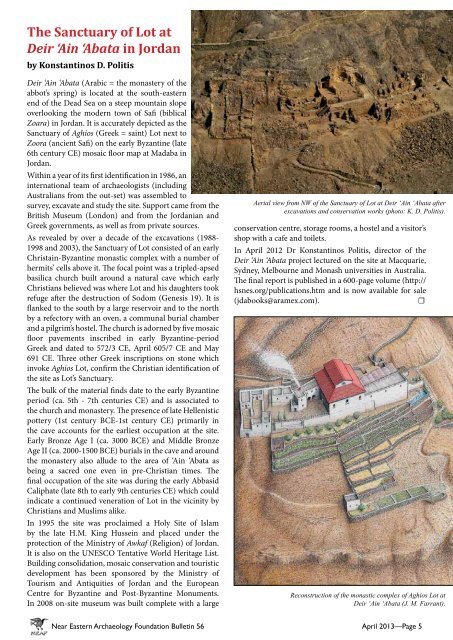Download Bulletin Issue #56 - The University of Sydney
Download Bulletin Issue #56 - The University of Sydney
Download Bulletin Issue #56 - The University of Sydney
Create successful ePaper yourself
Turn your PDF publications into a flip-book with our unique Google optimized e-Paper software.
<strong>The</strong> Sanctuary <strong>of</strong> Lot at<br />
Deir ‘Ain ‘Abata in Jordan<br />
by Konstantinos D. Politis<br />
Deir ‘Ain ‘Abata (Arabic = the monastery <strong>of</strong> the<br />
abbot’s spring) is located at the south-eastern<br />
end <strong>of</strong> the Dead Sea on a steep mountain slope<br />
overlooking the modern town <strong>of</strong> Safi (biblical<br />
Zoara) in Jordan. It is accurately depicted as the<br />
Sanctuary <strong>of</strong> Aghios (Greek = saint) Lot next to<br />
Zoora (ancient Safi) on the early Byzantine (late<br />
6th century CE) mosaic floor map at Madaba in<br />
Jordan.<br />
Within a year <strong>of</strong> its first identification in 1986, an<br />
international team <strong>of</strong> archaeologists (including<br />
Australians from the out-set) was assembled to<br />
survey, excavate and study the site. Support came from the<br />
British Museum (London) and from the Jordanian and<br />
Greek governments, as well as from private sources.<br />
As revealed by over a decade <strong>of</strong> the excavations (1988-<br />
1998 and 2003), the Sanctuary <strong>of</strong> Lot consisted <strong>of</strong> an early<br />
Christain-Byzantine monastic complex with a number <strong>of</strong><br />
hermits’ cells above it. <strong>The</strong> focal point was a tripled-apsed<br />
basilica church built around a natural cave which early<br />
Christians believed was where Lot and his daughters took<br />
refuge after the destruction <strong>of</strong> Sodom (Genesis 19). It is<br />
flanked to the south by a large reservoir and to the north<br />
by a refectory with an oven, a communal burial chamber<br />
and a pilgrim’s hostel. <strong>The</strong> church is adorned by five mosaic<br />
floor pavements inscribed in early Byzantine-period<br />
Greek and dated to 572/3 CE, April 605/7 CE and May<br />
691 CE. Three other Greek inscriptions on stone which<br />
invoke Aghios Lot, confirm the Christian identification <strong>of</strong><br />
the site as Lot’s Sanctuary.<br />
<strong>The</strong> bulk <strong>of</strong> the material finds date to the early Byzantine<br />
period (ca. 5th - 7th centuries CE) and is associated to<br />
the church and monastery. <strong>The</strong> presence <strong>of</strong> late Hellenistic<br />
pottery (1st century BCE-1st century CE) primarily in<br />
the cave accounts for the earliest occupation at the site.<br />
Early Bronze Age I (ca. 3000 BCE) and Middle Bronze<br />
Age II (ca. 2000-1500 BCE) burials in the cave and around<br />
the monastery also allude to the area <strong>of</strong> ‘Ain ‘Abata as<br />
being a sacred one even in pre-Christian times. <strong>The</strong><br />
final occupation <strong>of</strong> the site was during the early Abbasid<br />
Caliphate (late 8th to early 9th centuries CE) which could<br />
indicate a continued veneration <strong>of</strong> Lot in the vicinity by<br />
Christians and Muslims alike.<br />
In 1995 the site was proclaimed a Holy Site <strong>of</strong> Islam<br />
by the late H.M. King Hussein and placed under the<br />
protection <strong>of</strong> the Ministry <strong>of</strong> Awkaf (Religion) <strong>of</strong> Jordan.<br />
It is also on the UNESCO Tentative World Heritage List.<br />
Building consolidation, mosaic conservation and touristic<br />
development has been sponsored by the Ministry <strong>of</strong><br />
Tourism and Antiquities <strong>of</strong> Jordan and the European<br />
Centre for Byzantine and Post-Byzantine Monuments.<br />
In 2008 on-site museum was built complete with a large<br />
Aerial view from NW <strong>of</strong> the Sanctuary <strong>of</strong> Lot at Deir ‘Ain ‘Abata after<br />
excavations and conservation works (photo: K. D. Politis).<br />
conservation centre, storage rooms, a hostel and a visitor’s<br />
shop with a cafe and toilets.<br />
In April 2012 Dr Konstantinos Politis, director <strong>of</strong> the<br />
Deir ‘Ain ‘Abata project lectured on the site at Macquarie,<br />
<strong>Sydney</strong>, Melbourne and Monash universities in Australia.<br />
<strong>The</strong> final report is published in a 600-page volume (http://<br />
hsnes.org/publications.htm and is now available for sale<br />
(jdabooks@aramex.com).<br />
☐<br />
Reconstruction <strong>of</strong> the monastic complex <strong>of</strong> Aghios Lot at<br />
Deir ‘Ain ‘Abata (J. M. Farrant).<br />
Near Eastern Archaeology Foundation <strong>Bulletin</strong> 56 April 2013—Page 5
















